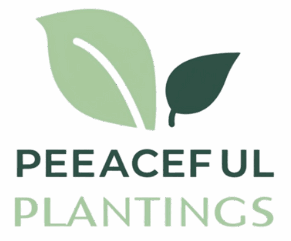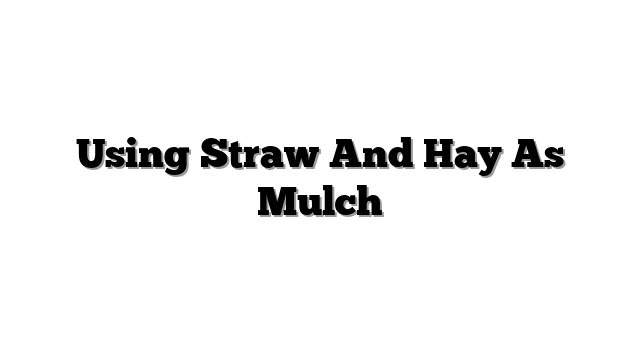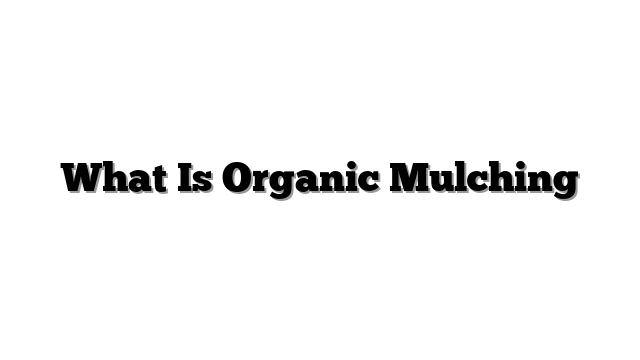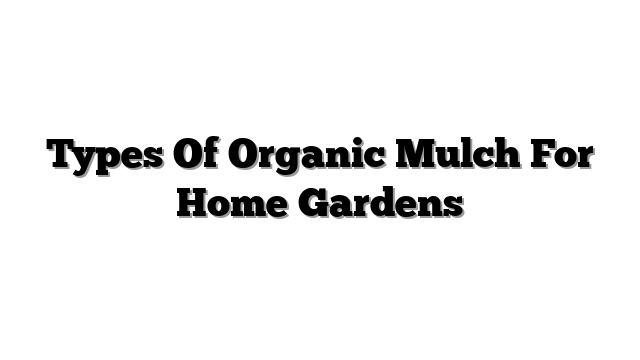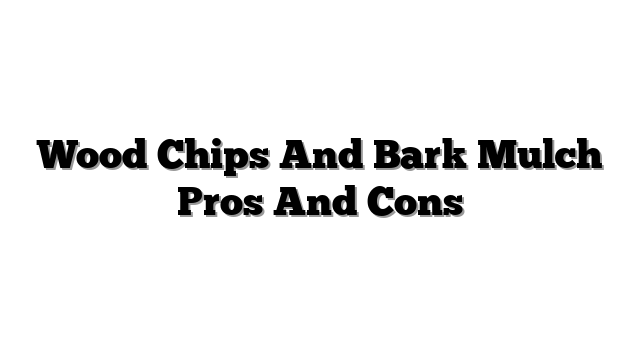Using Straw And Hay As Mulch
We all love our gardens. But weeds grow fast. Soil dries out quickly. Plants can struggle sometimes. Mulch offers a simple fix. It covers the soil surface. Many mulches exist. Straw and hay are popular choices. They are often low in cost. We use them in organic gardens. They help us garden sustainably.
This article helps you learn more. We cover Using Straw and Hay as Mulch. What is the difference? What good things do they do? How do you put them down? What problems might happen? We share simple gardening tips. You will learn about soil health. We talk about plant health too. Let’s start exploring this topic.
What Exactly Are Straw and Hay Mulch?
Let’s learn about straw first. It comes from grains. Think wheat or barley. Farmers cut the grain tops. They leave the stalks behind. Straw is just these dry stalks. It looks light yellow. Straw is quite brittle. It breaks easily. Straw usually has few seeds. This is good for mulching.
Now, think about hay. Hay is dried grass. Farmers cut it green. They cut it before it makes seeds. Hay is for feeding animals. It has whole plants. It includes stalks and leaves. Hay looks greener or golden. It feels softer than straw. Hay often has many seeds. These are grass seeds or weed seeds. This can cause problems later.
Here is the main difference. Straw is grain stalks. Hay is dried grass. Straw has few seeds. Hay often has many seeds. This matters for weed control. Straw breaks down slowly. Hay breaks down faster. Both add organic matter. This helps the soil.
Source quality matters a lot. Get clean straw or hay. Ask the farmer questions. Did they use weed killers? Persistent herbicides can harm plants. Choose bales that look clean. They should smell fresh.
The Abundant Benefits of Mulching with Straw and Hay
Straw and hay help gardens greatly. They fit sustainable gardening. They make gardening easier.
They stop weeds from growing. A thick layer blocks sun. Weed seeds need sun to sprout. This layer prevents weed growth. It gives good weed control. Put mulch down after weeding. This works best.
They keep soil moist. The mulch layer covers the soil. It stops water from leaving. This saves water. This helps soil moisture. Water your garden well first. Then add the mulch.
Mulch controls soil temperature. It keeps soil cooler in summer. It keeps roots happy. It keeps soil warmer in winter. This is good winter mulch. It helps plants handle cold. Soil temperature stays steady.
Mulch makes soil better. Straw and hay break down slowly. This decomposition adds organic matter. Organic matter improves soil. It makes soil loose. Water drains better. Roots grow easily. Earthworms love it. They help soil health.
Mulch protects the soil. Rain can hit bare soil hard. Mulch breaks the rain’s fall. It stops soil erosion. It keeps soil in place. It prevents soil compaction. Your feet won’t pack the soil down.
Mulch keeps fruits clean. Think of strawberries. They sit on the soil. Mulch lifts them up. Tomatoes stay clean too. Squash rests on clean mulch.
Straw and hay save money. Bales cost less than bags. This is cost-effective mulch. It covers big areas cheaply.
They are also renewable. Farmers grow grains and grass yearly. Straw and hay are natural. They fit organic mulch options. This is sustainable gardening.
“Mulch is like a blanket for your soil,” one expert said. It does so many good things.
A recent study showed something interesting. Gardens with mulch needed less water. They used 50% less water. That saves money and water. This helps water conservation.
Straw vs. Hay: Making the Right Choice for Your Garden
Straw and hay are different. The big difference is seeds. Hay often has many seeds. These seeds can sprout. They create new weeds. This affects weed control.
Choose straw most times. It has fewer seeds. It works well for weed control. Use it in vegetable beds. Put it around flowers. Use it on paths. Straw protects plants in winter. It is good winter mulch. Straw is better for mulching vegetable gardens. It gives fewer weed problems. Straw breaks down slower. It lasts longer.
You can choose hay sometimes. Use it where you will dig later. Sheet mulching uses hay. It breaks down faster. It adds nutrients faster. Hay has more nutrients than straw. It has less than compost.
Be careful with hay. Avoid hay with visible seeds. It can bring many weeds. This makes weed control harder.
Think about cost and where you live. Prices change. Availability changes. Straw and hay are usually cheap. They are cost-effective mulch.
Mix straw or hay with compost. This helps soil health more. It adds more organic matter.
Many gardeners prefer straw. “I always use straw for my vegetables,” one gardener shared. “Hay brought too many weeds.” This is a common experience.
How to Apply Straw and Hay Mulch for Maximum Benefit
Putting down mulch is easy. Some steps help a lot. They make mulch work best.
First, prepare the area. Pull out all existing weeds. Good weed control starts now. Mulch prevents new weeds. It does not kill old ones.
Water the soil well. Make sure the soil is wet. Mulch will keep this moisture in. This locks in soil moisture.
Add compost if you want. Put fertilizer down now. This feeds the soil. It helps with nitrogen depletion later. Microbes use nitrogen to break down mulch.
Now, apply the mulch. Break apart the bale. Make the straw or hay loose. It should be fluffy.
Put down a thick layer. Aim for 2 to 4 inches thick. This is after it settles. This mulch layers thickness is key. It stops weeds. It holds soil moisture.
Do not pile mulch high. Keep it away from plant stems. Leave one or two inches open. This stops rot. It prevents garden pests from hiding there.
Cover all bare soil. Weeds grow where soil shows. Mulch the whole area.
Use more mulch on paths. Make paths 4 to 6 inches thick. Weed control is the goal here.
Mulching vegetable gardens is simple. Put mulch around small plants carefully. Use it around bigger plants. It works for tomatoes. It helps potatoes grow. It keeps strawberries clean.
Straw and hay work in no-till gardening. They are good for sheet mulching too.
Check your mulch often. It gets thinner as it breaks down. Add more when needed. This keeps the mulch layers thick.
“Apply mulch like frosting on a cake,” one gardener said. “Cover everything evenly.”
Potential Challenges and How to Overcome Them
Straw and hay work well. Sometimes small problems happen. We can fix them.
Challenge 1: Weed Seeds. Hay often has seeds. These seed heads (hay) sprout. Your garden gets weeds. Weed control becomes hard.
Solution: Use straw instead. Straw has fewer seeds. Buy certified weed-free hay. It costs more. You can also cover hay. Let it sit in the sun. This might kill seeds. Pull any sprouts you see.
Challenge 2: Nitrogen Tie-up. Mulch breaks down. Tiny living things do this. They use nitrogen from the soil. This is nitrogen depletion. Plants might look yellow.
Solution: This is usually temporary. It happens near the soil surface. It might not affect plants much. Add compost or fertilizer first. This adds nitrogen. Feed plants if they look yellow. Soil health improves over time.
Challenge 3: Attracting Pests. Mulch can be wet. It can hide slugs and snails. Voles might live in thick mulch. These are garden pests.
Solution: Keep mulch away from stems. Leave that small gap. Check the mulch often. Use traps if needed. A healthy garden helps. Good soil health supports helpful bugs.
Challenge 4: Mulch Mats Down. Wet mulch can get flat. It can repel water. Water won’t reach the soil.
Solution: Fluff the mulch before you put it down. Do not apply it soaking wet. Break up matted spots with a rake. Water slowly and deeply. This helps water go through.
Challenge 5: Bad Source Quality. Hay or straw can have chemicals. It might have mold.
Solution: Buy from good farms. Ask how they grow it. Avoid bales that smell bad. Do not use moldy bales.
These problems are manageable. Most times, straw or hay works great.
FAQs about Using Straw and Hay as Mulch
People ask questions about mulch. Here are some common ones.
Is hay mulch bad because of weed seeds?
Hay can have weed seeds. These seed heads (hay) can sprout. This makes weed control hard. Straw is usually better. It has fewer seeds. Find weed-free hay if you use hay.
How thick should I apply straw or hay mulch?
Put down 2 to 4 inches. This is after it settles. Thicker is better for paths. Use 4 to 6 inches there. This depth helps weed control. It keeps soil moisture too. These are good mulch layers.
Will using straw or hay mulch attract pests?
Sometimes. Slugs or snails might hide there. Garden pests could live in thick mulch. Keep mulch away from stems. This helps a lot. Healthy plants resist pests better. Plant health improves with mulch.
How long does straw or hay mulch last?
It lasts one season or longer. This depends on the weather. It depends on how thick it is. Hay breaks down faster than straw. This decomposition adds organic matter. It helps soil health over time. You will need to add more later.
Can I use straw or hay mulch on all types of plants?
Yes, generally. It works well for mulching vegetable gardens. Use it around flowers and bushes. Keep it away from very small seedlings at first. Always leave space around the plant base. These are simple gardening tips.
Conclusion
Using Straw and Hay as Mulch helps your garden. It stops many weeds. This is great weed control. It keeps soil wet. This saves water and helps soil moisture. It makes soil better over time. It adds organic matter. This improves soil health.
Remember the difference. Straw has fewer seeds. Hay can have many seed heads. Choose straw for fewer weeds.
Straw and hay are cheap. They are cost-effective mulch. They are natural. They fit sustainable gardening.
They make plants healthier. Good mulch means good plant health.
Try Using Straw and Hay as Mulch in your garden. It is a simple step. It makes a big difference. Your garden will thank you. Explore more ways to garden sustainably. Look into other organic mulch options. Learn more about water conservation. Find guides for plant care. Ask questions if you have them. We are here to help.
